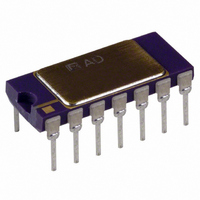AD636KD Analog Devices Inc, AD636KD Datasheet - Page 7

AD636KD
Manufacturer Part Number
AD636KD
Description
IC TRUE RMS/DC CONV MONO 14-CDIP
Manufacturer
Analog Devices Inc
Datasheet
1.AD636JDZ.pdf
(16 pages)
Specifications of AD636KD
Rohs Status
RoHS non-compliant
Current - Supply
800µA
Voltage - Supply
±2.5 V ~ 16 V
Mounting Type
Through Hole
Package / Case
14-CDIP (0.300", 7.62mm)
Available stocks
Company
Part Number
Manufacturer
Quantity
Price
+V
APPLYING THE AD636
The input and output signal ranges are a function of the supply
voltages as detailed in the specifications. The AD636 can also be
used in an unbuffered voltage output mode by disconnecting
the input to the buffer. The output then appears unbuffered
across the 10 kΩ resistor. The buffer amplifier can then be used
for other purposes. Further, the AD636 can be used in a current
output mode by disconnecting the 10 kΩ resistor from the
ground. The output current is available at Pin 8 (Pin 10 on the
H package) with a nominal scale of 100 μA per volt rms input,
positive out.
STANDARD CONNECTION
The AD636 is simple to connect for the majority of high
accuracy rms measurements, requiring only an external
capacitor to set the averaging time constant. The standard
connection is shown in
AD636 measures the rms of the ac and dc level present at the
input but shows an error for low frequency inputs as a function
of the filter capacitor, C
4 μF capacitor is used, the additional average error at 10 Hz is
0.1%, and at 3 Hz it is 1%. The accuracy at higher frequencies is
according to specification. If it is desired to reject the dc input, a
capacitor is added in series with the input, as shown in Figure 6;
the capacitor must be nonpolar. If the AD636 is driven with
power supplies with a considerable amount of high frequency
ripple, it is advisable to bypass both supplies to ground with 0.1 μF
ceramic discs as near the device as possible. C
output ripple filter.
OPTIONAL TRIMS FOR HIGH ACCURACY
If it is desired to improve the accuracy of the AD636, the
external trims shown in
trim the offset. The scale factor is trimmed by using R1 as
shown. The insertion of R2 allows R1 to either increase or
decrease the scale factor by ±1.5%.
erms
BUF OUT
–V
+
BUF IN
C
–
–V
C
V
NC
dB
AV
IN
S
1
2
3
4
5
6
7
NC = NO CONNECT
AD636
BUF
+
–
ABSOLUTE
10kΩ
SQUARER
CURRENT
DIVIDER
MIRROR
VALUE
Figure 4. Standard RMS Connection
10kΩ
AV
Figure 4. In this configuration, the
Figure 5 can be added. R4 is used to
14
13
12
11
10
+V
9
8
, as shown in Figure 8. Therefore, if a
COM
R
I
S
NC
NC
NC
OUT
L
(OPTIONAL)
+V
C
F
+V
+V
COM
(OPTIONAL)
S
erms
3
2
C
V
R
IN
F
+
C
AD636
L
AV
4
1
–
10kΩ
F
ABSOLUTE
–V
SQUARER
is an optional
CURRENT
MIRROR
DIVIDER
VALUE
I
S
–V
OUT
10
5
+
BUF
–
10kΩ
9
6
C
AV
BUF IN
8
7
BUF OUT
Rev. D | Page 7 of 16
dB
V
OUT
The trimming procedure is as follows:
•
•
SINGLE-SUPPLY CONNECTION
The applications in Figure 4 and Figure 5 assume the use of dual
power supplies. The AD636 can also be used with only a single
positive supply down to 5 V, as shown in Figure 6. Figure 6 is
optimized for use with a 9 V battery. The major limitation of
this connection is that only ac signals can be measured because
the input stage must be biased off ground for proper operation.
This biasing is done at Pin 10; therefore, it is critical that no
extraneous signals be coupled into this point. Biasing can be
accomplished by using a resistive divider between +V
ground. The values of the resistors can be increased in the
interest of lowered power consumption, because only 1 μA of
current flows into Pin 10 (Pin 2 on the H package).
Alternately, the COM pin of some CMOS ADCs provides a suitable
artificial ground for the AD636. AC input coupling requires only
Capacitor C2 as shown; a dc return is not necessary because it is
provided internally. C2 is selected for the proper low frequency
break point with the input resistance of 6.7 kΩ; for a cut-off at 10
Hz, C2 should be 3.3 μF. The signal ranges in this connection are
slightly more restricted than in the dual supply connection. The
load resistor, R
erms
Ground the input signal, V
output from Pin 6. Alternatively, R4 can be adjusted to give
the correct output with the lowest expected value of V
Connect the desired full-scale input level to V
or a calibrated ac signal (1 kHz is the optimum frequency);
then trim R1 to give the correct output from Pin 6, that is,
200 mV dc input should give 200 mV dc output. Of course,
a ±200 mV peak-to-peak sine wave should give a 141.4 mV
dc output. The remaining errors, as given in the specifications,
are due to the nonlinearity.
FACTOR
ADJUST
SCALE
±1.5%
200Ω
Figure 5. Optional External Gain and Output Offset Trims
R1
V
–V
OUT
BUF OUT
BUF IN
L
, is necessary to provide current sinking capability.
–V
C
dB
NC
AV
V
S
IN
1
2
3
4
5
6
7
AD636
NC = NO CONNECT
– BUF
+
10kΩ
ABSOLUTE
SQUARER
CURRENT
DIVIDER
MIRROR
VALUE
–
C
AV
+
IN
10kΩ
, and adjust R4 to give 0 V
14
13
12
11
10
9
8
+V
R
S
NC
NC
NC
COM
L
I
OUT
154Ω
R2
470kΩ
R3
+V
IN
, either dc
ADJUST
OFFSET
S
AD636
+V
–V
and
S
S
R4
500kΩ
IN
.













